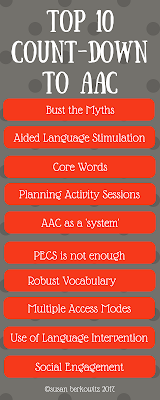I am so very excited to have Susan Berkowitz guest blogging today. When it comes to AAC, she is my go to gal. Being one of the old school SLPs, I had little to no training in school for helping people with this need. Through the years I managed to attend some training seminars and workshops, but never had it put all together for me, so I have asked Susan to do that for you.
In the SLP world, AAC has finally moved beyond its infancy, but there are still many clinicians who don’t know a whole lot about it. Many graduate programs do not offer a course in AAC, and it’s not a required course for licensure or certification.
But, these days there is probably not any population you might work with – infants to the elderly, from Autism to Aphasia to ALS to Cerebral Palsy to a whole list of chromosomal abnormalities. Any time someone can’t speak to meet all of their genuine communication needs, AAC should be a part of their toolbox.
So, what are the top 10 things to know about working with individuals and AAC? Here goes:
1. AAC has many myths surrounding it that prevent individuals’ access to it. AAC is not just for people who can’t speak at all; it won’t inhibit the development of speech in children or become a crutch; there is not a succession of AAC tools from no tech to low tech devices to – finally – dynamic display with voice output; there is also no hierarchy individuals must move through from objects to photographs to symbols; there are NO prerequisite skills one must have before being provided with AAC.
2. Aided Language Stimulation (ALgS) is a crucial ingredient to teaching someone to use AAC. Typical children learn to talk by listening to our models of talking. Deaf children learn sign language by seeing it used all the time around them. But picture-based communication users don’t usually see any consistent – or any at all – use of picture-based communication by anyone in the environment.
Having these models is very important. Communication partners should be using Aided Language Stimulation (also called Aided Input, Partner Aided Communication) by using the picture system when they communicate to the child.
3. Core words should be the initial focus of providing vocabulary to individuals learning to use AAC. Core words are the high frequency words that we use for most of what we say. For adults, 100 core words make up about 50% of our messages. Using the verbs and adjectives and pronouns that carry the most meaning in our language gives individuals more communication power with the least amount of language learning initially.
4. Planning is crucial when partners are using ALgS. Many partners are uncomfortable with the thought of having to use the child’s system to model language for them. Not knowing where vocabulary is located in the system, uncertainty about how to navigate to the correct page often makes partners reluctant to try.
I tell partners to start with just one activity that is familiar and comfortable. Plan out the vocabulary that you will need. What words are important to model for that activity? Planning ahead helps partners feel more comfortable about what they’re doing.
5. AAC is not just 1 “thing.” It’s not simply a communication book or board or a voice output device. A functional AAC system is a compilation of strategies that allow the individual to communicate effectively a variety of intents in a variety of contexts, with a variety of partners.
We need to recognize that different modes of communication are useful and necessary in different contexts while also remembering that we need to provide users with sufficient vocabulary – in whatever mode- to allow them to communicate genuine messages.
6. PECS is not enough. While the Picture Exchange Communication System is in popular use and is an accepted Evidence Based Practice for students with Autism, there are a few problems with using it as a mode of communication.
One of the things we’ve learned about implementing AAC is the need to model. I’ve never actually see Aided Input happening with any student I’ve known who was using a PECS board.
We also know that stability of location is important to becoming a competent communicator. But with PeCS, symbols with velcro are not usually returned to the same spot each time they are used.
A third point of research shows us that students need to have a robust vocabulary in order to use genuine communication across contexts and partners. Providing a user with a good sized base of core words is crucial, as well as having fringe vocabulary that is important to the specific user.
PECS is limiting in terms of the vocabulary and opportunities for syntax that the system provides. We need more than nouns, and more than a couple of sentence frames to build real language.
7. Robust vocabulary. There is that term again. What is a robust vocabulary? We want individuals to have access to a rich and flexible vocabulary that will meet all of their needs for communication for all types of functions. Limiting the number of words to which a student has access will only lead to frustration in the long run.
8. There are many ways of accessing an AAC system; not everyone can directly select a symbol or word. Some individuals will need to use scanning and a switch; some will need to use eye gaze; others will need a partner to scan for them. There are options! Your user does not need to be “able bodied.”
9. Language therapy is language therapy. AAC users may need a different mode of expression, but you do not need to use different materials in therapy. Just insure that you AAC user has a system with sufficiently robust vocabulary – and morphology – for all communication needs.
10. Don’t just focus on answering questions in class or asking for what the user wants or needs. Communication is social. It is about bringing us closer to others. Make sure your AAC user can, in fact, use the system, to bring him closer to others.
If you are looking for some robust AAC activities that focus on core vocabulary, provide background information that is evidence based, and create both fun contextual and decontextualized practice, try the AAC section of my store.
You’ll find a robust, core-based communication book, lots of fun activities and games to reinforce core words, and simulation activities your kids will love!
Susan Berkowitz Bio:
I have been a speech-language pathologist for >35 years, before which I taught kids with autism. I have been in the classroom, therapy room, and worked as an administrator. I have worked in public and nonpublic schools. I currently specialize in alternative-augmentative communication for nonverbal students and in training staff to implement aac in their classrooms. I teach workshops locally and nationally on augmentative communication and on teaching literacy skills to students with complex communication needs, and have written CEU on-line courses for SLPs about AAC. I have published research articles in peer reviewed journals, and spent considerable time working on translating research into practice.
I have a B.A. in Psychology, M.S. in Speech-Language Pathology, M. Ed. in School Administration, and extensive graduate level classes in Special Education (enough for a whole other Master’s degree – but why?). I believe this varied background has given me a deeper understanding of what these kids – and their teachers – need.







2 thoughts on “My Top 10 Must-Know Tips for AAC (Augmentative-Alternative Communication)”
I wanted to say that I have loved this blog.Very informative post with lots of information included in
the posting.You have made some really good points here ! Please find our link ,if you may be interested
in ,please refer to
Speech Pathologists Mailing list & Email list
This comment has been removed by the author.